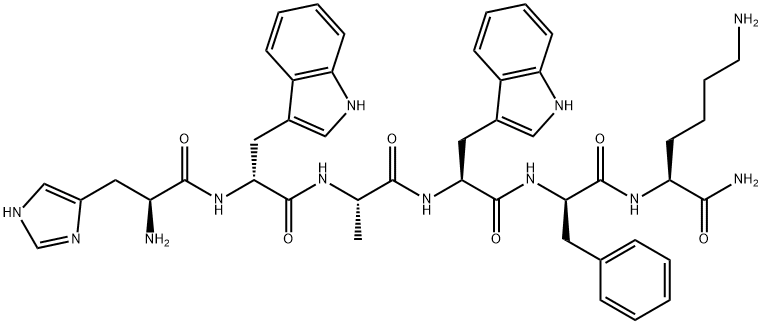Growth hormone releasing peptide
Synonym(s):GHRP-6
- CAS NO.:87616-84-0
- Empirical Formula: C46H56N12O6
- Molecular Weight: 873.01
- MDL number: MFCD00872694
- EINECS: 212-729-3
- SAFETY DATA SHEET (SDS)
- Update Date: 2024-12-23 19:56:12

What is Growth hormone releasing peptide?
Description
Growth hormone-releasing peptides (GHRPs) are synthetic, non-natural peptides endowed with potent stimulatory effects on somatotrope secretion in animals and humans. They have no structural homology with GHRH and act via specific receptors present either at the pituitary or the hypothalamic level both in animals and in humans.
The Uses of Growth hormone releasing peptide
Growth hormone releasing peptide-6 can promote the secretion of growth hormone, regulate food intake, increase weight, and promote animal growth.
The Uses of Growth hormone releasing peptide
L-Histidyl-D-tryptophyl-L-alanyl-L-tryptophyl-D-phenylalanyl-L-lysinamide is a growth hormone releasing peptide.
Benefits
When Growth hormone releasing peptide is administered, a selective pulse is sent to the brain that stimulates the hypothalamus and anterior pituitary to release growth hormones. Once this pulse is sent, the cells go directly to the muscle to support development while staying clear of any possible bone or cartilage growth. When the Peptide is injected it increases cell synthesis, elevates secretion levels of insulin from pancreatic tissue, and increases ghrelin in the stomach—which helps release GH and control hunger. All of these functions work to promote fat loss, shuttling of nutrients, and building clean muscle mass.
Mechanism of action
Growth hormone releasing peptide is generally accepted that GHRPs stimulate the release of GH by acting at the level of the pituitary through a receptor different to that for the endogenous GH-releasing hormone (GHRH). In addition, it has been reported that there are specific binding sites for these peptides in the hypothalamus and that systemic administration of GHRPs increases the expression of the immediate early gene c-fos in a subpopulation of hypothalamic neurons.
Side Effects
Carpal tunnel syndrome.Increased insulin resistance.
Type 2 diabetes.
Swelling in the arms and legs (edema)
Joint and muscle pain.
For men, enlargement of breast tissue (gynecomastia).
Increased risk of certain cancers.
Physiological effects
Growth hormone releasing peptide (GHRP) is a cyclase inhibitor that blocks the release of endogenous growth hormone.The peptide acts on both igf-i and somatotrophs, with receptor activity in the hypothalamus.GHRP can be used to increase body weight and control obesity.It has been shown to stimulate cell division and inhibit apoptosis in vitro.
Solubility in water
It is recommended to reconstitute the lyophilized growth hormone releasing peptide in sterile 18MΩ-cm H2O not less than 100 μg/ml, which can then be further diluted to other aqueous solutions.
storage
Lyophilized Growth hormone releasing peptide although stable at room temperature for 3 weeks, should be stored desiccated below -18°C. Upon reconstitution Growth hormone releasing peptide should be stored at 4°C between 2-7 days and for future use below -18°C. For long term storage it is recommended to add a carrier protein (0.1% HSA or BSA). Please prevent freeze-thaw cycles.
Properties of Growth hormone releasing peptide
| Melting point: | >160o C (Dec.) |
| Boiling point: | 1407.0±65.0 °C(Predicted) |
| Density | 1.333±0.06 g/cm3(Predicted) |
| storage temp. | −20°C |
| solubility | Methanol (Slightly), Water (Slightly) |
| form | Solid |
| pka | 13.42±0.46(Predicted) |
| color | White to Off-White |
| CAS DataBase Reference | 87616-84-0(CAS DataBase Reference) |
Safety information for Growth hormone releasing peptide
| Signal word | Warning |
| Pictogram(s) |
 Exclamation Mark Irritant GHS07 |
| GHS Hazard Statements |
H302:Acute toxicity,oral H315:Skin corrosion/irritation H319:Serious eye damage/eye irritation H335:Specific target organ toxicity, single exposure;Respiratory tract irritation |
| Precautionary Statement Codes |
P261:Avoid breathing dust/fume/gas/mist/vapours/spray. P305+P351+P338:IF IN EYES: Rinse cautiously with water for several minutes. Remove contact lenses, if present and easy to do. Continuerinsing. |
Computed Descriptors for Growth hormone releasing peptide
| InChIKey | WZHKXNSOCOQYQX-FUAFALNISA-N |
| SMILES | C(N)(=O)[C@H](CCCCN)NC(=O)[C@@H](CC1=CC=CC=C1)NC(=O)[C@H](CC1C2=C(C=CC=C2)NC=1)NC(=O)[C@H](C)NC(=O)[C@@H](CC1C2=C(C=CC=C2)NC=1)NC(=O)[C@H](CC1N=CNC=1)N |
New Products
Tert-butyl bis(2-chloroethyl)carbamate 4-Methylphenylacetic acid N-Boc-D-alaninol N-BOC-D/L-ALANINOL N-octanoyl benzotriazole 3-Morpholino-1-(4-nitrophenyl)-5,6-dihydropyridin- 2(1H)-one Furan-2,5-Dicarboxylic Acid DIETHYL AMINOMALONATE HYDROCHLORIDE 1,1’-CARBONYLDIIMIDAZOLE R-2-BENZYLOXY PROPIONIC ACID 1,1’-CARBONYLDI (1,2-4 TRIAZOLE) N-METHYL INDAZOLE-3-CARBOXYLIC ACID (2-Hydroxyphenyl)acetonitrile 4-Bromopyrazole 5-BROMO-2CYANO PYRIDINE 5,6-Dimethoxyindanone 5-broMo-2-chloro-N-cyclopentylpyriMidin-4-aMine 2-(Cyanocyclohexyl)acetic acid 4-methoxy-3,5-dinitropyridine 1-(4-(aminomethyl)benzyl)urea hydrochloride 2-aminopropyl benzoate hydrochloride diethyl 2-(2-((tertbutoxycarbonyl)amino) ethyl)malonate tert-butyl 4- (ureidomethyl)benzylcarbamate Ethyl-2-chloro((4-methoxyphenyl)hydrazono)acetateRelated products of tetrahydrofuran








You may like
-
![[D-Trp7, Ala8, D-Phe10]-α-Melanocyte Stimulating Hormone Amide Fragment 6-11 CAS 87616-84-0](https://img.chemicalbook.in//Content/image/CP5.jpg) [D-Trp7, Ala8, D-Phe10]-α-Melanocyte Stimulating Hormone Amide Fragment 6-11 CAS 87616-84-0View Details
[D-Trp7, Ala8, D-Phe10]-α-Melanocyte Stimulating Hormone Amide Fragment 6-11 CAS 87616-84-0View Details
87616-84-0 -
 1975-50-4 98%View Details
1975-50-4 98%View Details
1975-50-4 -
 2-HYDROXY BENZYL ALCOHOL 98%View Details
2-HYDROXY BENZYL ALCOHOL 98%View Details
90-01-7 -
 2-Chloro-1,3-Bis(Dimethylamino)Trimethinium Hexafluorophosphate 221615-75-4 98%View Details
2-Chloro-1,3-Bis(Dimethylamino)Trimethinium Hexafluorophosphate 221615-75-4 98%View Details
221615-75-4 -
 61397-56-6 CIS BROMO BENZOATE 98%View Details
61397-56-6 CIS BROMO BENZOATE 98%View Details
61397-56-6 -
 14714-50-2 (2-Hydroxyphenyl)acetonitrile 98+View Details
14714-50-2 (2-Hydroxyphenyl)acetonitrile 98+View Details
14714-50-2 -
 118753-70-1 98+View Details
118753-70-1 98+View Details
118753-70-1 -
 733039-20-8 5-broMo-2-chloro-N-cyclopentylpyriMidin-4-aMine 98+View Details
733039-20-8 5-broMo-2-chloro-N-cyclopentylpyriMidin-4-aMine 98+View Details
733039-20-8